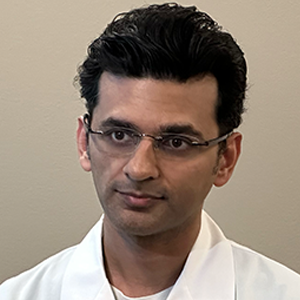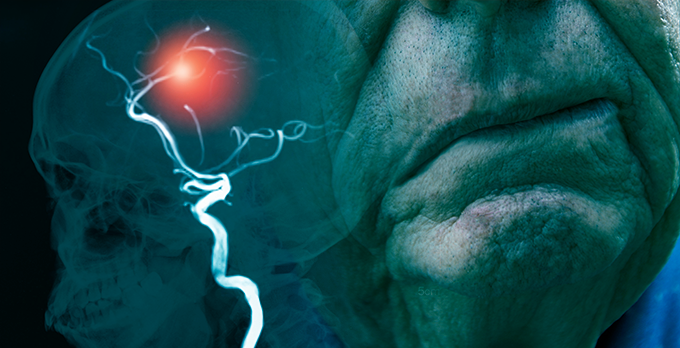One person has a stroke in the United States every 40 seconds, according to the Stroke Awareness Foundation.
“One person in the United States dies from stroke every three minutes,” said Tarun Girotra, MD.
Girotra is one of multiple stroke neurologists at The University of New Mexico Hospital’s award-winning Stroke Center. Always prepared to deliver the most advanced stroke care in New Mexico, the care center operates 24 hours a day, seven days a week and treats close to 800 stroke and suspected stroke patients every year.

“Whenever a patient comes to UNM Hospital, they will be seen by a team of multidisciplinary providers, nurses and techs, and we have round-the-clock neurologists, neurosurgeons, radiologists and emergency medicine with a common focus or common goal of delivering the fastest, most accurate care to all of our stroke patients.”
“We see this very commonly, and it is actually the most common cause of serious long-term disability,” Girotra said.
May is stroke awareness month, but it is always important to understand this life-threatening, neurological emergency.
What is a stroke?
There are two types of stroke: ischemic and hemorrhagic. Ischemic is the most common, affecting 85% of stroke patients. As explained by Girotra, these occur when a clot gets stuck in one of the brain arteries, which prevents blood flow to that part of the brain. Hemorrhagic strokes, making up 15% of cases, happen when the blood artery ruptures, which leads to bleeding in the brain tissue.
“Both of them can be life threatening, and deadly, and both of them can have a significant impact on a person's ability to do their day-to-day activities,” Girotra said. “We treat both of them with the same amount of importance, but in essence, they both are different diseases, and they both have different lines of treatment.”
Before anyone can seek the right treatment, they must first learn how to identify whether or not they are having a stroke.
The acronym BE FAST makes it easier to remember the signs and symptoms to watch out for when identifying a potential stroke.
Balance: Sudden loss of balance, dizziness, trouble walking
Eyes: Blurred, doubled or loss of vision in either or both eyes, without pain
Face: One side of the face is drooping or is visually uneven
Arm: Inability to hold arm straight or it drifts down when held out
Speech: Slurred or garbled speech, inability to speak
Time: Note the time symptoms set in and immediately call 911
Treatment of an ischemic stroke within the first four hours of symptoms is crucial to a patient’s outcome.
“If a person does not recognize their stroke symptoms on time, and they get to the emergency room after four and a half hours, they are not eligible to receive clot-dissolving medicines,” Girotra said. “Getting this medicine 30 minutes after the stroke symptoms starting is going to have a much better outcome than getting it at four hours. So, the sooner the treatment is given, the better the chances are.”
What should you do if you believe you are having a stroke?
If you or a loved one are exhibiting any of the above systems, Girotra said do not try to drive to the emergency room yourself. Call 911.
First responders are trained to quickly identify which type of stroke a patient is experiencing, deliver immediate care if possible, and relay information to the team at UNM Hospital so they can prepare while the patient is on the way.
What does UNM Hospital when a stroke patient arrives?
UNM Hospital’s Stroke Center receives 10 to 12 stroke patients every single day.
“This number has been steadily growing every year because of the investment of the University Health System into the Stroke Program, and the awareness with our EMTs and community about stroke symptoms and what to do when they have stroke symptoms,” Girotra said.
Patients transported by ambulance are immediately met by the hospital stroke team when they arrive, so they do not have to spend any time waiting in the emergency room. Every second counts. Depending on what type of stroke a patient is experiencing, there are different treatment options, including the injection of a clot-dissolving medication called Tenecteplase (TNK) and surgical clot removal.
“We have a team of dedicated doctors who can actually take a catheter wire up to the brain arteries and basically remove the clot and restore the blood supply immediately,” Girotra said. “We have seen some significant improvement and outcomes in people who have come in completely paralyzed on one side and literally walked out of the hospital a day or two later because of this procedure.”
Girotra said stroke patients who respond well to treatment can be discharged from the hospital within 48 to 72 hours. Often, patients require additional time in the hospital and are transferred to rehabilitation facilities for further care.
How can you prevent a stroke?
Girotra said strokes can happen out of the blue, even if a person has done nothing to trigger one, and most of the time it is a painless condition, unlike a heart attack. So, it is easier for symptoms to go undetected for those who do not know what specific signs to look for.
Some things to be aware of that may increase risk of stroke include:
- Having African American, Hispanic, American Indian or Alaska Native heritage
- Daily smoking
- Family history of heart attack before age 55 for men, or age 65 for women
- High blood cholesterol
- High blood pressure
- Less than 30 minutes of physical activity most days of the week
- Being overweight or obese
- Personal history of heart disease, heart attack, stroke, abnormal heartbeat and/or diabetes
A person may be able to reduce their risk of stroke by cutting back on alcohol, drug use, smoking, managing diabetes and sticking to a healthy diet.
But if stroke happens, the team at the UNM Hospital Stroke Center is always ready.
“Whenever a patient comes to UNM Hospital, they will be seen by a team of multidisciplinary providers, nurses and techs, and we have round-the-clock neurologists, neurosurgeons, radiologists and emergency medicine with a common focus or common goal of delivering the fastest, most accurate care to all of our stroke patients,” Girotra said.
To learn more about the UNM Hospital Stroke Center, stroke care, prevention, symptoms, recovery and follow-up, click here.
